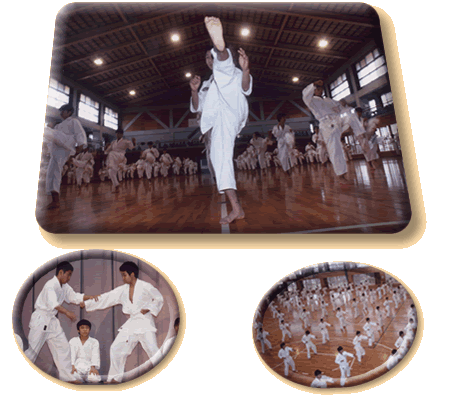| A Visit to Okinawan Schools |

At Furugen Middle School in the village of Yomitan, 150 eighth-grade boys are practicing karate. In time with a powerful drum beat and instructions like "Right frontal kick! Left frontal kick!" they all go through their moves with great strength. Teachers Mr. Nakayoshi and Mr. Arakaki report: "We focus on the things the students need the most, like strength and power, control, and keri (kicks). In other classes the students learn the connection between karate and the history of Okinawa. Seeing the students trying their best makes us teachers very happy."
"The thing that makes karate a lot of fun," one of the students enthused, "is when the moves fall exactly into place."
At the Yomitan Middle School, seventh-grade boys demonstrate bojutsu (stick fighting) during physical education class. They have very bright costumes. They perform in pairs, moving with long and short poles in time with the fast rhythm of drums, conch horns, and gongs, and it's very exciting. Attacking your opponent is not the aim of bojutsu. As with other Okinawan martial arts that used everyday objects and farming tools--such as hoes, sickles, and spatulas--or just their hands and feet, the object is to defend oneself.
At the Yomitan Elementary School, fourth- to sixth-grade students from the sanshin club practise playing this traditional Okinawan instrument. The sanshin has three strings and is shaped like a guitar, with a body covered with snakeskin. Encouraged by their enthusiastic teacher, Ms. Ikehara, about 40 students perform on the sanshin and koto, a harp-like instrument. They play and sing folk melodies unique to Okinawa so well that it's hard to believe they are just school kids.
At Kochinda Middle School, performances are put on by students enrolled in elective arts classes. The school in the town of Kochinda allows students to choose one of several kinds of traditional Okinawan performing arts to study. "Acting in a fight scene with a long spear was exhausting," Ruri Nohara said as she came off stage. "And at first I had to write down all my lines to remember them."
Another student, Hidetake Adaniya said, "The small dance steps and movements were really hard, but I think the performance went pretty well, so I'm very happy."
Traditional performing arts in Okinawa are alive and well and appear likely be passed down to future generations by today's young performers.
|
|